Today’s Current Affairs:13th October 2025 for UPSC IAS exams, State PSC exams, SSC CGL, State SSC, RRB, Railways, Banking Exam & IBPS, etc
Table of Contents
Hwasong-20:
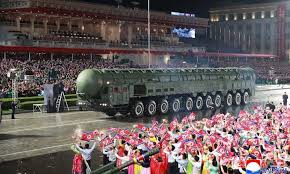
North Korea recently unveiled its latest and most powerful intercontinental ballistic missile Hwasong-20 at a military parade presided over by the country’s leader Kim Jong Un.
- It is an intercontinental ballistic missile (ICBM) developed by North Korea.
- The engine used in the missile is a solid-fuel engine and is made up of carbon fiber composite materials.
- Solid-fueled rockets can be moved more easily and fired more quickly, in a matter of minutes, than liquid-fueled versions, making them harder to defend against
- It has a range of over 15,000 km.
- It is equipped with an advanced guidance system that combines an inertial guidance system (INS) with GPS or optical sensors for enhanced accuracy.
- Intercontinental Ballistic Missile (ICBM) is a land-based, nuclear-armed ballistic missile with a range of more than 3,500 miles (5,600 km).
- The first ICBMs were deployed by the Soviet Union in 1958; the United States followed the next year and China some 20 years later.
- ICBMs can be launched from silos underground, mobile launchers on land, or submarines at sea.
- Countries having operational ICBMs: Russia, United States, China, France, India, United Kingdom, Israel and North Korea.
Palau:
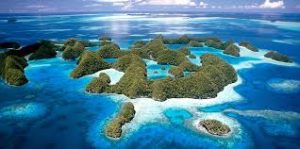
Palau recently hosted the world’s first-ever live underwater interview.
- It is an island nation located in the western Pacific Ocean.
- It consists of a tightly clustered archipelago of approximately 300 islands with a total land area of 458 sq.km.
- It is geographically positioned both in the Northern and Eastern hemispheres of the Earth.
- Palau shares maritime borders with the Federated States of Micronesia to the east, with Indonesia to the south, with Philippines to the west, and with the international waters to the north.
- Located on Babeldaob (the largest island of Palau) is Ngerulmud – the capital of Palau.
- It is the world’s least populous capital city.
- Koror is the largest and the most populous city of Palau. It acts as the main commercial center of Palau.
- Languages: Palauan, English, plus Japanese, Sonsorolese, and Tobian.
- Palau became independent in 1994, after being part of a United Nations trust territory administered by the US.
- It relies on financial aid from the US, provided under a Compact of Free Association, which gives the US responsibility for Palau’s defence and the right to maintain military bases
Microfinance Loan Defaults Surge in 2024–25: Sa-Dhan’s Bharat Microfinance Report
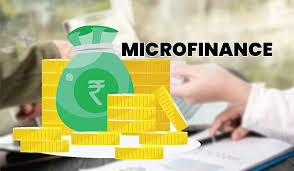
Microfinance loan defaults in India have risen sharply in FY 2024–25, according to Sa-Dhan’s Bharat Microfinance Report 2025.
- Sa-Dhan, India’s self-regulatory body for microfinance institutions (MFIs), publishes the annual Bharat Microfinance Report tracking sectoral credit performance and financial inclusion outcomes.
- The proportion of microfinance loans overdue by more than 30 days (PAR 30+) rose to 6.2% in FY25, up from 2.1% in FY24.
- Loans overdue by more than 90 days—considered NPAs—jumped to 4.8%, from 1.6% the previous year.
- Bihar led with ₹57,712 crore in outstanding microfinance loans; 7.2% were delayed over 30 days, and 4.6% were delayed beyond 90 days.
- Of the ₹2.3 lakh crore loans to rural borrowers, 6.4% were overdue beyond 30 days—higher than urban (6%) and semi-urban (6.1%) borrowers, reflecting deepening rural repayment stress.
India–UK Connectivity and Innovation Centre:
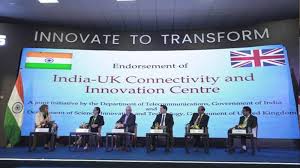
India and the United Kingdom jointly launched the India–UK Connectivity and Innovation Centre (CIC) to advance cooperation in digital technologies, 6G research, and secure communications, with an investment of million (₹282 crore) over four years.
- The India–UK CIC is a bilateral research and innovation platform aimed at developing next-generation telecom technologies through joint academic, industrial, and governmental collaboration. It will serve as a hub for cutting-edge R&D, testing, and market deployment in digital connectivity.
- Nations and Organisations Involved: Countries: India and the United Kingdom
- Implementing Agencies:
- India – Department of Telecommunications (DoT), Ministry of Communications
- UK – Department of Science, Innovation and Technology (DSIT)
- Supported by UK Research and Innovation (UKRI) under the UK–India Technology Security Initiative
- Aim is to drive innovation in secure, inclusive, and resilient digital communications, while shaping the global ecosystem for 6G and AI-enabled telecom systems, aligned with the India–UK 2035 Vision.
- Key Features: Joint Funding: million (approx. ₹282 crore) committed equally by both nations for 4 years.
- Focus Areas:
- AI in Telecom: Network optimization and intelligent service delivery.
- Non-Terrestrial Networks (NTNs): Satellite and airborne systems for rural connectivity.
- Telecom Cybersecurity: Secure, interoperable, and open communication infrastructure.
- Collaborative Research: Links university research with lab testing and pilot trials.
- Joint Testbeds: Establishes shared facilities for real-world application of emerging technologies.
- Standards Development: Encourages global interoperability through participation in international standard-setting bodies.
Qubit:

Caltech has built the world’s largest neutral-atom qubit array—6,100 qubits—pushing quantum computers closer to error correction and full-scale computation.
- A qubit, or quantum bit, is the basic unit of information used to encode data in quantum computing.
- It can be best understood as the quantum equivalent of the traditional bit used by classical computers to encode information in binary.
- In classical computing the information is encoded in bits, where each bit can have the value zero or one.
- In quantum computing the information is encoded in qubits. A qubit is a two-level quantum system where the two basis qubit states are usually written as ∣0⟩ and ∣1⟩.
- A qubit can be in state ∣0⟩, ∣1⟩, or (unlike a classical bit) in a linear combination of both states.
- The name of this phenomenon is superposition.
- The term “qubit” is attributed to American theoretical physicist Benjamin Schumacher.
- Qubits are generally, although not exclusively, created by manipulating and measuring quantum particles (the smallest known building blocks of the physical universe), such as photons, electrons, trapped ions, superconducting circuits and atoms.
- Enabled by the unique properties of quantum mechanics, quantum computers use qubits to store more data than traditional bits, vastly improve cryptographic systems and perform very advanced computations that would take thousands of years (or be impossible) for even classical supercomputers to complete.
Pradhan Mantri Dhan-Dhaanya Krishi Yojana:
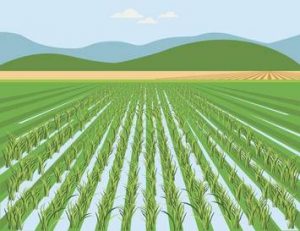
The Prime Minister recently launched two new agriculture schemes, the PM Dhan Dhaanya Krishi Yojana (PMDDKY) and the Mission for Aatmanirbharta in Pulses, with a total outlay of `35,440 crore.
- It is a new scheme by the Indian government to support farmers.
- Under this scheme, farmers get direct financial help, new farming tools, crop insurance, and better market access.
- It targets 100 underperforming districts where farming faces challenges like low crop yields, water scarcity, and limited access to resources.
- It aims to support 1.7 crore farmers, particularly small and marginal farmers owning less than 2 hectares of land, who constitute 86% of India’s farming population.
- PMDDKY consolidates 36 existing agricultural schemes across 11 ministries, including PM-KISAN (cash transfers), PMFBY (crop insurance), PMKSY (irrigation), and Rashtriya Krishi Vikas Yojana (RKVY), into a unified program to streamline efforts and maximize impact.
- PMDDKY focuses on regions with low crop yields (e.g., wheat yields below 3.5 tonnes/hectare compared to the national average), moderate cropping intensity (below 155%, meaning fewer than 1.55 crop cycles per year), and limited access to credit.
- The scheme operates under the Ministry of Agriculture and Farmers’ Welfare, with oversight from a National Steering Committee, state-level nodal committees, and District Dhan Dhaanya Samitis led by District Collectors.
- PMDDKY’s Objectives:
- Increase crop yields by 20-30% through high-quality inputs and technology.
- Reduce reliance on monsoons with advanced irrigation systems like drip and sprinkler.
- Provide affordable tools and mechanization to enhance efficiency.
- Build storage infrastructure to cut post-harvest losses to under 5%.
- Offer loans and direct market access to double farmer incomes by 2030, aligning with the government’s extended goal from 2022 due to economic disruptions like COVID-19.
- Promote sustainable practices like organic farming to protect soil and water resources.
- Support women, youth, and allied sectors (e.g., dairy, fisheries, poultry) to diversify income sources.
- Achieve self-sufficiency in foodgrains, pulses, and oilseeds to reduce India’s dependence on imports.
- Key Benefits of PMDDKY:
- Increased Crop Yields: Access to high-yielding seeds (e.g., hybrid wheat yielding 4 tonnes/hectare), bio-fertilizers, and mechanized tools like seed drills to boost production.
- Higher Income: Diversifying into high-value crops like pulses (₹80-100/kg) and vegetables, and direct market access through apps to increase profits by 20-40%.
- Sustainable Farming: Organic fertilizers, water-saving irrigation, and climate-resilient crops to maintain soil health and reduce environmental impact.
- Irrigation Systems: Drip and sprinkler systems to ensure water availability, enabling year-round farming in dry regions.
- Storage Facilities: Village and block-level warehouses and cold storage to prevent spoilage of 20% of perishables like fruits, vegetables, and dairy.
- Financial Support: Subsidies (50-80% off inputs) and loans (short-term: ₹50,000–₹1 lakh; long-term: ₹1–10 lakh) through Kisan Credit Cards or NABARD.
- Market Access: Digital platforms like e-NAM and new PMDDKY apps to connect farmers directly to buyers, reducing middlemen and boosting profits.
- Training and Skill Development: Free workshops by Krishi Vigyan Kendras (KVKs), agricultural universities, and private partners on modern farming, drone use, and allied activities like beekeeping.
- Women Empowerment: Support for 10,000 women producer groups with training, loans, and market linkages for activities like dairy or organic farming.
- Global Exposure: Fully funded international training for 500 farmers in countries like Israel (expertise in drip irrigation), Japan (precision farming), or the Netherlands (greenhouse technology).
Keratoconus:

A recent study has revealed that the treatment of keratoconus, a condition that threatens vision, can worsen even after treatment.
- It is a vision disorder that occurs when the normally round cornea (the front part of the eye) becomes thin and irregular (cone) shaped.
- This abnormal shape prevents the light entering the eye from being focused correctly on the retina and causes distortion of vision.
- Keratoconus often starts when people are in their late teens to early 20s.
- The vision symptoms slowly get worse over a period of about 10 to 20 years.
- It often affects both eyes and can lead to very different vision between the two eyes.
- Symptoms can differ in each eye, and they can change over time.
- Treatment and Prevention:
- There is no known prevention for keratoconus.
- Early stages can be treated with glasses, but with progression of the disease into late childhood and early adulthood, corneal transplantation may be needed to restore sight.
- Corneal collagen cross-linking is a procedure designed to stop the progression of keratoconus or slow it down.
Siddi Tribal community:
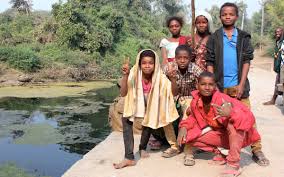
The President of India expressed happiness that the Siddi tribal community, a Particularly Vulnerable Tribal Group, has achieved a literacy rate of over 72 per cent.
- The Siddi community is an Indo-African tribal community that descended from the Bantu community of Africa.
- It is believed that they first came to India in the 7th century with Arab merchants and in the 16th century with the Portuguese and British, largely as slaves, servants, blacksmiths, carpenters and masons.
- In the present day, the majority of them are found in the west and southwest of India, in Gujarat, Maharashtra, Karnataka and Telangana states.
- In India, the Union government on January 8, 2003, classified Siddis under the list of Scheduled Tribes. They are included in the Centre’s list of Particularly Vulnerable Tribal Groups.
- Occupation: Traditional dependence on agriculture, forest produce, and manual labor
- Language: They speak either Konkani, Urdu or Marathi as their main language.
- Culture: They are known for their folk music and dances, such as Dhamal and Rasda, with men performing the Dhamal dance.
Bharat Taxi Initiative:
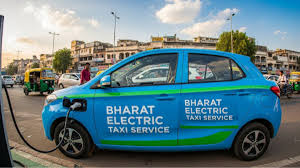
The National e-Governance Division (NeGD), Digital India Corporation, Ministry of Electronics & Information Technology (MeitY), has joined hands with Sahakar Taxi Cooperative Limited to support the upcoming Bharat Taxi initiative.
- It is a first-of-its-kind cooperative-driven, citizen-first national ride-hailing initiative.
- It is being jointly promoted by leading cooperative and financial institutions including NCDC, IFFCO, AMUL, KRIBHCO, NAFED, NABARD, NDDBand NCEL.
- It reflects the cooperative movement’s spirit and also aligns with the vision of the Government’s flagship Digital India programme for delivering inclusive, citizen-centric, and technology-enabled public services.
- Under this initiative NeGD provides the Bharat Taxi platform with:
- Platform Integration & Technical Architecture: Integration of the Bharat Taxi platform with national digital platforms such as DigiLocker, UMANG, and API Setu to enable seamless identity verification and service delivery.
- Security, Compliance & Infrastructure:Ensuring adherence to Government of India’s data protection norms and cybersecurity standards and advising on robust technical infrastructure.
- Programme Advisory:Providing governance and programme management support leveraging NeGD’s institutional experience in designing and implementing large-scale national platforms.
- UI/UX & Accessibility:Offering advisory inputs on user interface design, multilingual capabilities, and inclusive access features for all citizens.
Green Sea Turtle: Improved From Endangered To Least Concern
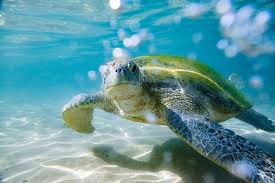
According to the International Union for Conservation of Nature (IUCN) the Red List status of the green sea turtle (Chelonia mydas) has improved from Endangered to Least Concern due to sustained conservation.
- Green Sea Turtle is the largest hard-shelled sea turtle.
- The common name of this species refers to the usually green fat found beneath its carapace, not to the color of its carapace, which is olive to black.
- Green turtles serve as keystone species in tropical marine ecosystems.
- The species is found in tropical and subtropical waters around the globe.
- They have a comparatively small head.
- They do not have teeth, but their jaws have modified “beaks” suited to their particular diet.
- They do not have visible ears but have eardrums covered by skin. They hear best at low frequencies, and their sense of smell is excellent.
- They spend almost all their lives underwater and come out of the water only when nesting.
- Lifespan: Estimated to be 60-70 years.
- Conservation Status: IUCN: Least Concern
Research Development and Innovation Scheme:
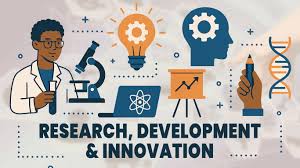
The Executive Council of the Anusandhan National Research Foundation approved the establishment of a special purpose fund (SPF) for the Research Development and Innovation Scheme (RDI) scheme.
- It aims to provide long-term financing or refinancing with long tenors at low or nil interest rates to spur private sector investment in Research Development and Innovation.
- Key objectives of the Research Development and Innovation Scheme:
- Encourage the private sector to scale up research, development, and innovation (RDI) in sunrise domains and in other sectors relevant for economic security, strategic purpose, and self-reliance;
- Finance transformative projects at higher levels of Technology Readiness Levels (TRL)
- Support acquisition of technologies which are critical or of high strategic importance;
- Facilitate setting up of a Deep-Tech Fund of Funds.
- The Governing Board of Anusandhan National Research Foundation (ANRF), chaired by the Prime Minister, will provide overarching strategic direction to the RDI Scheme.
- Nodal Department: The Department of Science & Technology (DST).
SPARK– 4.0:
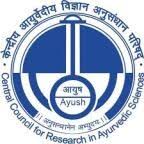
The Central Council for Research in Ayurvedic Sciences (CCRAS) under the Ministry of Ayush has launched SPARK–4.0 (2025–26).
- SPARK–4.0 (Studentship Program for Ayurveda Research Ken) is the fourth edition of CCRAS’s flagship initiative to encourage research orientation among BAMS undergraduates.
- Implemented by the Central Council for Research in Ayurvedic Sciences (CCRAS) under the Ministry of Ayush, Government of India.
- Aim is to cultivate scientific curiosity and develop a research mindset in young Ayurveda scholars while bridging classical knowledge with modern scientific methods.
- Key features:
- 300 BAMS students to be awarded ₹50,000 studentships (₹25,000 per month for two months).
- Open to students from National Commission for Indian System of Medicine NCISM-recognized colleges across India.
- Involves faculty-guided, short-term independent research projects.
- Students receive a certificate after successful completion.
The Supreme Court of India has temporarily halted the Aravalli Jungle Safari Project:
The Supreme Court of India has temporarily halted the Aravalli Jungle Safari Project in Haryana, citing concerns over its environmental impact on one of India’s most ecologically sensitive regions that serves as the green lung of Delhi-NCR. Aravalli Jungle Safari Project: Announced in 2022, the project aims to build the world’s largest jungle safari near Gurugram and Nuh. Inspired by Sharjah Safari (UAE) and Gir Sanctuary (Gujarat), it includes zones for big cats, bird parks, herpetarium, underwater world, and eco-tourism trails.Aravalli Range is considered one of the oldest mountain systems in the world. It spans over 800km from Gujarat to Delhi (through Rajasthan and Haryana). The highest peak in the Aravalli Range is Guru Peak (Guru Shikhar) on Mount Abu (also known as Arbuda). The range gives rise to rivers like the Banas, Sahibi (tributaries of the Yamuna), and Luni (flowing into the Rann of Kutch).
The Aravalli Range is divided into two sections: the Sambhar-Sirohi range, which includes Guru Peak, and the Sambhar-Khetri range. Rich in minerals and natural resources, the range acts as a barrier against the western desert.It is densely forested in the south, and much of the range is rocky, sparsely populated, and covered with quartzite and sand
Project Waterworth:
Meta Platforms has chosen Mumbai and Visakhapatnam as the landing sites for the India leg of its multibillion-dollar undersea cable project Waterworth.Project Waterworth is a subsea cable initiative by Meta Platforms aimed at strengthening global data connectivity. It connects the US, India, Brazil, and South Africa, making it the world’s longest subsea cable, spanning over 50,000 km.Project Waterworth features a W-shaped route that bypasses the Red Sea corridor, reducing risks from geopolitical conflicts and cable damages. Expected to be operational by 2030, with a design capacity of 1 petabit per second (Pbps).The chosen landing sites in India enhance the country’s role in global AI infrastructure, support data localisation, and strengthen India’s digital ecosystem.
Demographic Mission:
Prime Minister of India in his Independence Day 2025 address, announced the launch of a high-powered Demographic Mission to counter illegal infiltration and address emerging demographic challenges.The Demographic Mission is a proposed national initiative aimed at monitoring, managing, and analysing India’s demographic transformations — including fertility, mortality, migration, and population distribution — to ensure balanced growth, national security, and sustainable development.Aim is to curb illegal infiltration and protect border regions from demographic shifts, To promote a holistic understanding of India’s population dynamics, integrating social, economic, and human development indicators.
Digital Examinations:
A recent analysis highlighted how digital examinations can replace traditional paper-based tests in India’s higher education system, offering a sustainable, cost-effective, and transparent alternative aligned with the goals of Digital India and NEP 2020.Over 4.3 crore students in Indian higher education appear for nearly 100 crore exams annually, generating massive paper consumption.Each tree yields about 8,000 sheets of paper—the current system leads to millions of trees being cut down every year for exam use.Transitioning even 50% of exams online could save lakhs of trees and prevent thousands of tonnes of CO₂ emissions annually.Universities spend crores annually on printing, logistics, and storage; digital exams reduce operational costs by 30–40% while delivering results faster and more transparently.
Purple Fair 2025:
Goa Chief Minister Dr. Pramod Sawant inaugurated the 3rd edition of the International Purple Fair 2025 – Celebrating Diversity. The event, organized to showcase the talent, entrepreneurship, and empowerment of persons with disabilities (PwDs), underscores India’s journey towards an inclusive and accessible society.Theme Purple Fair 2025 : Launched under the theme “Celebration of Inclusion, Talent and Empowerment,”. The Purple Fair has evolved into a flagship festival symbolizing dignity, innovation, and equality for all.
Castrol India:
Castrol India, a major player in the lubricant sector, is undergoing a leadership transition. Kedar Lele, the current Managing Director, is set to step down at the end of December 2025 to explore new opportunities. In his place, the company has appointed Saugata Basuray as Interim CEO, starting January 2026, while he retains his existing role as Wholetime Director & Head of B2C Sales.From 1 January 2026, Saugata Basuray will assume the additional title of Interim CEO, until a permanent Managing Director is appointed. He continues to hold his prior position as Wholetime Director & Head, B2C Sales.
In light of the new appointment, his designation will be redefined as “Wholetime Director & Interim CEO.”Basuray is a seasoned Castrol veteran, having served the company since 1999 in various leadership capacities across regions and verticals.
Bumrah Becomes First Indian Pacer with 50 Matches:
Jasprit Bumrah etched his name in the record books by becoming the first Indian fast bowler to play 50 Test matches across all international formats. The feat was achieved during the second Test match against the West Indies at the Arun Jaitley Stadium in Delhi on October 10, 2025. This milestone solidifies Bumrah’s legacy as one of India’s finest modern pacers.Bumrah’s 50th red-ball appearance came in a dominant Test outing for India against the visiting West Indies team, where he featured in the Shubman Gill-led side.India had already secured a victory in the first Test in Ahmedabad, and entered the Delhi Test with momentum.
India will send Buddha’s sacred relics to Kalmykia, Russia:
The Government of India has announced that the sacred relics of Lord Buddha will be sent to Russia’s Kalmykia Republic for the first-ever public exposition. The event, to be held in Elista, the capital of Kalmykia, will run from October 11 to 18, aiming to bless the local Buddhist population and strengthen spiritual and cultural connections.The relics, preserved at the National Museum in New Delhi, are believed to date back to the time of the Shakyamuni Buddha and are among the most venerated in Buddhist traditions.They were excavated from Piprahwa in Uttar Pradesh—an archaeological site linked to the ancient kingdom of Kapilavastu.Kalmykia stands out as the only Buddhist-majority region in Europe.Its people, predominantly followers of Tibetan Buddhism, have been revitalizing their spiritual institutions after decades of Soviet-era suppression.Hosting Buddha’s relics is seen as a moment of deep cultural pride and spiritual rejuvenation for the local population.
Rishi Sunak Joins Microsoft and Anthropic as Adviser:
Former UK Prime Minister Rishi Sunak has taken on new roles in the global technology sector by joining Microsoft and Anthropic, a leading artificial intelligence company, as a senior adviser. These part-time, non-policy roles will see Sunak offering strategic guidance on macroeconomic and geopolitical trends, further marking his transition from public office to international corporate engagement.Sunak’s appointments were announced in early October 2025. He described the companies as two of the “world’s leading tech firms” in a LinkedIn post and expressed his excitement to contribute to their global missions.
Delhi Declaration Elevates Global South Cities at COP30:
With climate diplomacy increasingly focused on implementation on the ground, cities are asserting their role as frontline actors. The Delhi Declaration on Local Action for Global Climate Goals, adopted on October 9, 2025, at the first ARISE Cities Forum in New Delhi, marks a landmark moment. It amplifies the urban voice of the Global South, demanding that local governments be recognized as partners in the global climate regime. As the declaration is handed over to COP30 in Belém, Brazil, it sets the stage for stronger, locally grounded climate action.ARISE—Adaptive, Resilient, Innovative, Sustainable, and Equitable—is ICLEI South Asia’s flagship urban resilience forum. The 2025 edition, themed “From Bharat to Belém,” brings together mayoral, municipal, national, and global stakeholders.The Delhi Declaration is the intended collective outcome to be forwarded to COP30
Three Indian Ports Named Green Hydrogen Hubs:
India has taken a significant step toward building a future-ready green energy ecosystem by designating three major ports as Green Hydrogen Hubs. The Ministry of New and Renewable Energy (MNRE), under the framework of the National Green Hydrogen Mission, has formally recognised Deendayal Port (Gujarat), V.O. Chidambaranar Port (Tamil Nadu), and Paradip Port (Odisha) as focal points for green hydrogen production, distribution, and usage. This announcement marks a pivotal moment in India’s clean energy transition and aligns with the country’s broader ambition to achieve net-zero emissions by 2070.
3 Named Green Hydrogen Port:
- Deendayal Port Authority (Gujarat)
- V.O. Chidambaranar Port Authority (Tamil Nadu)
- Paradip Port Authority (Odisha)




